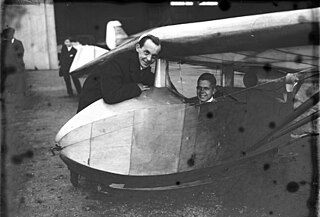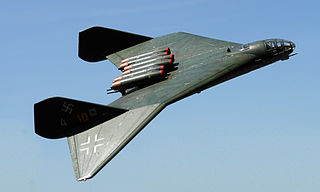
Alexander Martin Lippisch was a German aeronautical engineer, a pioneer of aerodynamics who made important contributions to the understanding of tailless aircraft, delta wings and the ground effect, and also worked in the U.S. Within the Opel-RAK program, he was the designer of the world's first rocket-powered glider.

The Messerschmitt Me 263 Scholle (plaice) was a rocket-powered fighter aircraft developed from the Me 163 Komet towards the end of World War II. Three prototypes were built but never flown under their own power as the rapidly deteriorating military situation in Germany prevented the completion of the test program.

The DFS 194 was a rocket-powered aircraft designed by Alexander Lippisch at the Deutsche Forschungsanstalt für Segelflug.

The Dornier Do 11 was a German heavy bomber, developed in secret in the early 1930s. It was originally called the Dornier F before being renamed by the Reichsluftfahrtministerium (RLM) in 1933, and was considered a heavy bomber at the time. It came into service in 1932, a continuation of a line of bomber designs from the Dornier Do P in 1930, and the Dornier Do Y in 1931. The line would continue to develop with the Dornier Do 13 and Dornier Do 23.

The Dornier Do 12 Libelle III was the third of a line of small German flying boats of the 1930s. It started with the Dornier A Libelle I and the Dornier A Libelle II, though the Do 12 was not a continuation, but an entirely new aircraft.
The Junkers Ju 187 was a German projected dive bomber designed to replace the ageing Junkers Ju 87 Stuka. The Ju 187 was cancelled in 1943.

The Junkers W 34 was a German-built, single-engine, passenger and transport aircraft. Developed in the 1920s, it was taken into service in 1926. The passenger version could take a pilot and five passengers.

The Arado E.555 was a long range strategic bomber proposed by the German Arado company during World War II in response to the RLM's Amerikabomber project. The E.555 designation was applied to a series of long range jet bomber designs of various sizes, powerplant, crew and weapon load configurations. As design studies only, no aircraft were developed or constructed and the entire E.555 project was cancelled at the end of 1944.

The Dornier Do 317 was a prototype German medium bomber of World War II.

The Henschel Hs 124 was Henschel's entry into the Luftwaffe's twin-engine Kampfzerstörer requirement, but was abandoned after this programme was split into separate Zerstörer and Schnellbomber requirements. Three prototypes were planned, but only two were built

The Dornier Do 214 was a proposed large long-range flying boat, developed by Dornier in World War II.

After the success of the 1940 airborne assaults involving the DFS 230, the Reichsluftfahrtministerium invited the Deutsche Forschungsanstalt für Segelflug/DFS and Gotha to submit plans for a larger capacity glider. The result was the DFS 231, a twenty-seat troop designed by Hans Jacobs, who had previously produced the successful, nine seat DFS 230.
The Bücker Bü 134 was a German single engine, high wing cabin monoplane prototype designed and built by Bücker Flugzeugbau GmbH.

The Arado Ar 77 was a German twin-engined monoplane, designed as an advanced training aircraft from 1934.

The Fieseler Fi 99 Jungtiger was a German sports aircraft prototype, produced by Fieseler company. The aircraft was a low-wing two-seat aircraft with an enclosed cabin. It was powered by a Hirth HM 506A engine, producing 160 hp (119 kW).

The Albatros L102 / Albatros Al 102, was a German trainer aircraft of the 1930s. It was a parasol-wing landplane, seating the student pilot and instructor in separate, open cockpits. A biplane floatplane version was also built as the Al 102W, with strut-braced lower wings.
The Albatros L 103 / Albatros Al 103 was a German experimental aircraft of the 1930s. It was a parasol-wing landplane of conventional configuration, seating the pilot and flight test observer in separate, open cockpits. The Al 103 was used to test variations in sweepback, dihedral and tailplane area.

The Fieseler F 3 Wespe ("Wasp") was a German aircraft designed by Alexander Lippisch as the Delta IV and built by Fieseler. Lippisch later redesignated its variants as the Delta IVa and b, with the c variant being built as the DFS 39.
















